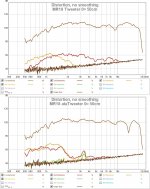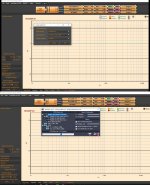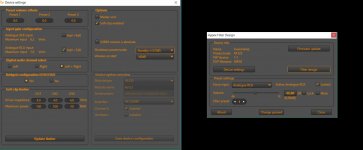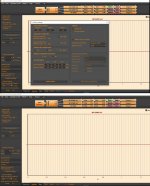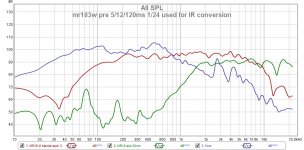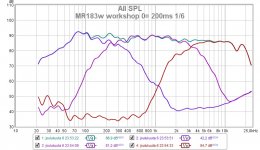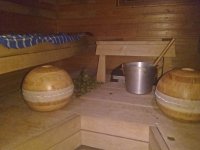Resonance treatment day
I put some synthetic felt pads on the edge of woofer's cone and measured the on-axis response. I call this success, 6dB reduction of 4kHz peak and only 1dB attenuation below 1kHz. Gotta find some black or grey pads...
Made some eq and a 3kHz LR2 xo. I am happy with this, room decay is usually longer around 2-4kHz which compensates extra directivity. Easy to fix sound signature with low Q eq too.
I will order Hypex Fusion amps soon and go on with bass box next week. I will put the amp on piece of board that fits the spit in the tube. The amp's plate has vents which will be blocked. Now I think that I will dress the cylinder with Marimekko Unikko cloth!



I put some synthetic felt pads on the edge of woofer's cone and measured the on-axis response. I call this success, 6dB reduction of 4kHz peak and only 1dB attenuation below 1kHz. Gotta find some black or grey pads...
Made some eq and a 3kHz LR2 xo. I am happy with this, room decay is usually longer around 2-4kHz which compensates extra directivity. Easy to fix sound signature with low Q eq too.
I will order Hypex Fusion amps soon and go on with bass box next week. I will put the amp on piece of board that fits the spit in the tube. The amp's plate has vents which will be blocked. Now I think that I will dress the cylinder with Marimekko Unikko cloth!
Last edited:
Black felt pads attached
Both drivers attached on bowls, bottom bowls planed to fit
Wooden legs for the speakers ordered
Hypex FA123 amps ordered
Jantzen Audio CrossCap 8.5uF caps ordered
SEAS alu tweeters ordered for testing Seas T18 koaksiaalielementin vaihtodiskantti, alumiinikalotti (mitataan ennen lahetysta) - Hifitalo
While waiting for deliveries I must make panels for amplifiers and fit them and top and bottom plates, then apply white matte paint on tubes.
Pics
Both drivers attached on bowls, bottom bowls planed to fit
Wooden legs for the speakers ordered
Hypex FA123 amps ordered
Jantzen Audio CrossCap 8.5uF caps ordered
SEAS alu tweeters ordered for testing Seas T18 koaksiaalielementin vaihtodiskantti, alumiinikalotti (mitataan ennen lahetysta) - Hifitalo
While waiting for deliveries I must make panels for amplifiers and fit them and top and bottom plates, then apply white matte paint on tubes.
Pics
Last edited:
Amps, tweeters and caps arrived. I purchased also some more plywood and 4-pole Neutrik connectors for the ball. The textile tweeter of MR18 has a copper ring unlike T18. It is glued on tight, I'll soon run some test how the mid and tweeter perform with the new alu-tweeter attached without the ring. I have some copper plates in the storage room so I can cut rings if needed.
Tomorrow I'll have a day off from work and start cutting some wood!
More pics
Tomorrow I'll have a day off from work and start cutting some wood!
More pics
Last edited:
Oops, I broke the unattached tweeter when trying to get the copper sleeve off. Must try to get replacement drivers... Aluminium T18 tweeters have less distortion but more ragged response obviously because the membrane sits more deeply in the throat of the cone.
LR2 at 3kHz seems to work just fine. Lower xo around 2-300Hz LR2 should work well too. I have been thinking about drilling holes on the backside bowl, or setting a large vent to make it a bad dipole and to get cardioid response around xo. This test will be done with the MT ball on the bass pole later on. I have one extra bowl for testing!
Check pics
LR2 at 3kHz seems to work just fine. Lower xo around 2-300Hz LR2 should work well too. I have been thinking about drilling holes on the backside bowl, or setting a large vent to make it a bad dipole and to get cardioid response around xo. This test will be done with the MT ball on the bass pole later on. I have one extra bowl for testing!
Check pics
Attachments
^Thanks! Whatever comes with acoustic LR2 crossovers and a closed box woofer! At this moment I don't even dream of FIR, and Hypex Filter Design does't support it.
https://www.diyaudio.com/forums/class-d/306815-hypex-fusion-plate-amps-65.html#post5444053
https://www.diyaudio.com/forums/class-d/306815-hypex-fusion-plate-amps-65.html#post5444053
Women come from Venus, but Hypex Filter Design and it's Help come from *nus!
I have spent about six hours of my and family's precious holiday time to get the FA board working and to start making xo. I have printed and read the HFD instructions, read the homepage (very poor) and read discussions at several forums. Installed ASIO4ALL driver, set in- and output correct, downloaded preset1 to the ampboard, but not a hiss!
The instructions are the worst I have ever read. Period.
There is no functional logic at all. At page 4 is chapter "Load measurements for speaker" but how can I have them because the amp is not even functional? Obviously I must first use some other amp and measurement system to get started and to get those spl or impulse .txt files. Why don't they say that directly????? What parameters and how should I name them?
Then later at page 5 tells to fill in your biquads and then "Load filter to DSP" ((Easy for you to say that!)
Graphical filter design starts at page 14, and it shows the downloded measurements per channel without saying how they came there.
Then finally at page 30 it starts telling about measurements "When your computer has recording capabilities.." without specifying the criteria for that. Then tells about ASIO settings. No instructions about how to set mic for measurements and what IR gating the program uses, only smoothing can be adjusted.
Obviously I must disconent the FA123 board and take measurements with REW, minidsp and some other amp to get started and to have something to load to the board.
Hypex should consult someone with at least some educational understanding to write the instructions and UI. If every discussion forum gets filled with questions about mute boards and simple basics to get started, the reputation and business gets ruined. I still want to believe that this is a good produt technically, only the UI and instructions are a catastrophe.
I have spent about six hours of my and family's precious holiday time to get the FA board working and to start making xo. I have printed and read the HFD instructions, read the homepage (very poor) and read discussions at several forums. Installed ASIO4ALL driver, set in- and output correct, downloaded preset1 to the ampboard, but not a hiss!
The instructions are the worst I have ever read. Period.
There is no functional logic at all. At page 4 is chapter "Load measurements for speaker" but how can I have them because the amp is not even functional? Obviously I must first use some other amp and measurement system to get started and to get those spl or impulse .txt files. Why don't they say that directly????? What parameters and how should I name them?
Then later at page 5 tells to fill in your biquads and then "Load filter to DSP" ((Easy for you to say that!)
Graphical filter design starts at page 14, and it shows the downloded measurements per channel without saying how they came there.
Then finally at page 30 it starts telling about measurements "When your computer has recording capabilities.." without specifying the criteria for that. Then tells about ASIO settings. No instructions about how to set mic for measurements and what IR gating the program uses, only smoothing can be adjusted.
Obviously I must disconent the FA123 board and take measurements with REW, minidsp and some other amp to get started and to have something to load to the board.
Hypex should consult someone with at least some educational understanding to write the instructions and UI. If every discussion forum gets filled with questions about mute boards and simple basics to get started, the reputation and business gets ruined. I still want to believe that this is a good produt technically, only the UI and instructions are a catastrophe.
Last edited:
I have few FA253s. 1 of 3 units was okay, one broken in two weeks and model ID wasn't programmed to one unit, but that was quite easy to fix with help of technical support.
New Filter Designer is more difficult than older version for UcD and PSC. I wouldn't say that it's from *nus. Primarily just different than some others, and requires experience or compatible thinking. Challenge for Hypex is to support many/all different models. I needed manual for one thing: to figure out how to switch BTL/SE modes so that something really happens. Rebooting of amp wasn't entirely logical imo.
Flat responses are default and mute works via main/ctrl window, so amp supports measurement of raw responses as any other device.
Measurements need usually (always at home) some processing; baffle loss simulation and merging of far and near, so valid speaker simulator or good measurement software is helpful. REW alone is not adequate for that. Simulators such as VCAD support filter types and responses of Hypex, so simulation is one method to create filter setup and add biquads without loading measurements to Filter Designer at all. Or you could design everything initially with simulator and load axial responses to Filter Designer for final tuning of filter parameters. But I guess that you would not do this...
New Filter Designer is more difficult than older version for UcD and PSC. I wouldn't say that it's from *nus. Primarily just different than some others, and requires experience or compatible thinking. Challenge for Hypex is to support many/all different models. I needed manual for one thing: to figure out how to switch BTL/SE modes so that something really happens. Rebooting of amp wasn't entirely logical imo.
Flat responses are default and mute works via main/ctrl window, so amp supports measurement of raw responses as any other device.
Measurements need usually (always at home) some processing; baffle loss simulation and merging of far and near, so valid speaker simulator or good measurement software is helpful. REW alone is not adequate for that. Simulators such as VCAD support filter types and responses of Hypex, so simulation is one method to create filter setup and add biquads without loading measurements to Filter Designer at all. Or you could design everything initially with simulator and load axial responses to Filter Designer for final tuning of filter parameters. But I guess that you would not do this...
Last edited:
I found the mute button and I tried to make sweep, there was a red line growing a little but no sound, the it halted. Had both L and R RCA-cable connected and RCA input forced.
Nice to know that there should be flat responses downloaded! I will try it again before disconnecting, after I regain my normal mental status... This learnig process is very exhausting anyway and whole family suffers, including my dear dog Willa!
REW can make biquads for Hypex boards too, I think. But like kimmosto knows, I am just a simple country boy who rejects proper simulations and likes to climb to a tree with bottom first
Nice to know that there should be flat responses downloaded! I will try it again before disconnecting, after I regain my normal mental status... This learnig process is very exhausting anyway and whole family suffers, including my dear dog Willa!
REW can make biquads for Hypex boards too, I think. But like kimmosto knows, I am just a simple country boy who rejects proper simulations and likes to climb to a tree with bottom first
Nice to know that there should be flat responses downloaded!
I'm not sure about this anymore. I got sound after adding one dummy flat biquad. It's kinda logical but disturbing.
I took some quick and extremely dirty measurements to be downloaded to HFD. Bass spl level is not comparable to M or T and I didn't even check polarities. All have different IR gating. I converted impulse responses as .txt so let's see what happens next!
More naughty pictures!
More naughty pictures!
Attachments
Last edited:
Just a bit more info. So, the other boad was ok and I couls start using HFD.
First, to get HFD to accet the IR from REW I had to edit .txt files, cut off all info on first 10 or so lines so that the file started straight from values. Then I downloaded the files as per instructions, loaded the Preset1 settings to the board and it started working! The led on the right upper edge of the board settled on Left speaker while on the bad board it went blank ater running all the lights.
I set ASIO4ALL settings correctly and started takin sweeps and settin biquads for eq. It seemed to work and I downloaded the better settings and save the project several times. The after fes measure-eq periods the HFD screen started to show asio settings and biquad settings overlaid, some biquads stopped from working and even after deleting all bq settings, the measured response showed highpass for the tweeter.
After setting biquads and measuring, the Save command from upper left corner wanted to save only the impulse response measured last. All settings coul be saved only by closing the whole HFD.
I didn't have time to find out how alls channels could be made to play simultaneusly with HFD (despite opening Mute buttons and clicking Sum for every channel only the channel that was active on display, put out sound.
Delay and gain settings per channel seemed to work.
I used also REW to check response, because HFD uses some IR gating that cannot be changed, I guess it might be N cycles/Frequency. Only smoothing could be changed.
Because all this hassle I didn't take screensot at all. I must continue learning and conslutl hypex if I can't make thing working. I might even return the boards and go to minidsp 2x4HD plus ICEpower or NCore amplifier boards.
First, to get HFD to accet the IR from REW I had to edit .txt files, cut off all info on first 10 or so lines so that the file started straight from values. Then I downloaded the files as per instructions, loaded the Preset1 settings to the board and it started working! The led on the right upper edge of the board settled on Left speaker while on the bad board it went blank ater running all the lights.
I set ASIO4ALL settings correctly and started takin sweeps and settin biquads for eq. It seemed to work and I downloaded the better settings and save the project several times. The after fes measure-eq periods the HFD screen started to show asio settings and biquad settings overlaid, some biquads stopped from working and even after deleting all bq settings, the measured response showed highpass for the tweeter.
After setting biquads and measuring, the Save command from upper left corner wanted to save only the impulse response measured last. All settings coul be saved only by closing the whole HFD.
I didn't have time to find out how alls channels could be made to play simultaneusly with HFD (despite opening Mute buttons and clicking Sum for every channel only the channel that was active on display, put out sound.
Delay and gain settings per channel seemed to work.
I used also REW to check response, because HFD uses some IR gating that cannot be changed, I guess it might be N cycles/Frequency. Only smoothing could be changed.
Because all this hassle I didn't take screensot at all. I must continue learning and conslutl hypex if I can't make thing working. I might even return the boards and go to minidsp 2x4HD plus ICEpower or NCore amplifier boards.
Jos from Hypex answered my first email. They have plans to work out the HFD guide.
--
I see the sample files are no longer included with the current software version. You can find still them in the old version which can be downloaded here Hypex Electronics B.V.
---
I checked the link and old version HFD 4.62 is not available any more! I fortunately had that package downloaded too so I copied the sample .dat files from there and added them to Filter Data folder created by v. 4.71 Don't run install! If someone else needs them, send me your email in private message!
I will try to get sound from the first board too, but I happen to have suitable ICEpower modules in my storage, two 2x50W ASX2 versions and two 125W btl-modules!
--
I see the sample files are no longer included with the current software version. You can find still them in the old version which can be downloaded here Hypex Electronics B.V.
---
I checked the link and old version HFD 4.62 is not available any more! I fortunately had that package downloaded too so I copied the sample .dat files from there and added them to Filter Data folder created by v. 4.71 Don't run install! If someone else needs them, send me your email in private message!
I will try to get sound from the first board too, but I happen to have suitable ICEpower modules in my storage, two 2x50W ASX2 versions and two 125W btl-modules!
Last edited:
Tried to continue tonight, but new configs made the FA123 mute again. I will return them.
Minidsp and ICEpower work like train's toilet! I must just cut an aluminium plate to attach amp modules inside the bass box, 2x4HD units will be taped on the outside just like in my Avalanche project. Master-slave system must be forgotten, but this will still be a pretty transparent system for the end user.
As the dsp-amp issue is now over, I will continue finishing the boxes! Aperiodic balls seem to work ok, not too much distortion in low end.
Minidsp and ICEpower work like train's toilet! I must just cut an aluminium plate to attach amp modules inside the bass box, 2x4HD units will be taped on the outside just like in my Avalanche project. Master-slave system must be forgotten, but this will still be a pretty transparent system for the end user.
As the dsp-amp issue is now over, I will continue finishing the boxes! Aperiodic balls seem to work ok, not too much distortion in low end.
Last edited:
DannerD3H gave me some valuable peer support and I celebrated the evening of Independece day with beautiful sounds from both FA123 plateamps!
I don't know what it exactly was, but main points were:
- set as Master, Full power
- set forced Analog RCA input
- load flat.dat response to all channels
- use different computer to feed audio and for measurements
- remember to toggle Upload settings to board after every change
- Live update doesn't work, all biquad changes must be uploaded to FA. Only mute, Delay, Invert and volume settings work directly. Using mute makes it easy to measure each channel/way separately.
It is not possible to download present settings from board to HFD program. This is nuisance, because later on I must remember which saved setting was uploaded. I put a note sticker on the board, marked with settings directory name. The actual config file is always named plainly config.xml.
Here are 200ms responses measured at 40cm distance from ball. So, this is nothing final yet, mid plays too loud, but usable in this stage. My off-axis measurements show that 6-9kHz has almost no directivity. But now they seem to work and I can go on finishing the boxes!
I don't know what it exactly was, but main points were:
- set as Master, Full power
- set forced Analog RCA input
- load flat.dat response to all channels
- use different computer to feed audio and for measurements
- remember to toggle Upload settings to board after every change
- Live update doesn't work, all biquad changes must be uploaded to FA. Only mute, Delay, Invert and volume settings work directly. Using mute makes it easy to measure each channel/way separately.
It is not possible to download present settings from board to HFD program. This is nuisance, because later on I must remember which saved setting was uploaded. I put a note sticker on the board, marked with settings directory name. The actual config file is always named plainly config.xml.
Here are 200ms responses measured at 40cm distance from ball. So, this is nothing final yet, mid plays too loud, but usable in this stage. My off-axis measurements show that 6-9kHz has almost no directivity. But now they seem to work and I can go on finishing the boxes!
Attachments
Last edited:
Having a sauna and shower room with heated floor helps a lot! Boxes and balls are in the owen now! I decided to use aperiodic vents in the balls. Original Gradient 1.4 has obviously several small perforation covered by backside grill. Backside radiation is basicallly dipole in low registry, in opposite phase to frontside. The 900Hz peak in backside measured response presents the internal standing wave leaking out.
MR18 3w active - Juhazi - Google Photos
MR18 3w active - Juhazi - Google Photos
Attachments
Last edited:
- Home
- Loudspeakers
- Multi-Way
- SEAS MR18 3-way
